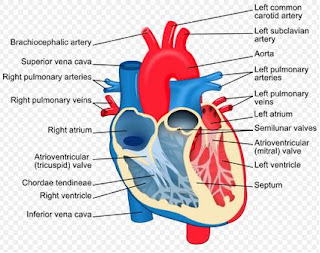Heart
The human heart is a specialized, have four chambered muscle that maintains blood flow in the circulatory system. The heart is located in the thorax, it lies on the left of the body's mid-line, above and in contact with the diaphragm. It is situated immediately behind the breastbone, or sternum, and between the lungs, with its apex titled to the left.
At rest the heart pumps about 59 cc (2 oz) of blood per beat and 5 l (5 qt) per minute, compared to 120 - 220 cc (4-7.3 oz) per beat and 20-30 l (21-32 qt) per minute during exercise. The adult human heart is about 250 - 350 gram (9 oz).
Blood supplies food and oxygen to the cells of the body for their life needs and removes the waste products of their chemical processes. It also helps to maintain a consistent body temperature, circulate hormones, and fight infections. Research indicates that the heart itself produces a hormonelike chemical. Brain cells are dependent on a constant oxygen supply, so death ensues shortly if a heart attack halts circulation to the brain. Such attacks are the number one cause of death in the United States.
Structure and function of the Human Heart
The heart's wall has three parts. Muscle tissue, or myocardium, is the middle layer. The inner layer, or endocardium, that lines the inside of the heart muscle consists of a thin layer of endothelial tissue overlying a thin layer of vascularized connective tissue. The outside of the heart, the epicardium, is in intimate contact sac. covering the heart muscle's outside wall. Within the sac. a small amount of fluid reduces the friction between the two layers of tissue. In addition to muscular and connected tissue, the heart muscle contains varying amounts of fatty tissue, especially on the outside. Both anatomically and functionally, the heart is divided into a left and a right half by the cardiac septum. Each half contains two separate spaces, the atrium, or collecting chambers, are the thin walled atria, and the lower pumping chambers are the thick walled ventricles.
At rest the heart pumps about 59 cc (2 oz) of blood per beat and 5 l (5 qt) per minute, compared to 120 - 220 cc (4-7.3 oz) per beat and 20-30 l (21-32 qt) per minute during exercise. The adult human heart is about 250 - 350 gram (9 oz).
Blood supplies food and oxygen to the cells of the body for their life needs and removes the waste products of their chemical processes. It also helps to maintain a consistent body temperature, circulate hormones, and fight infections. Research indicates that the heart itself produces a hormonelike chemical. Brain cells are dependent on a constant oxygen supply, so death ensues shortly if a heart attack halts circulation to the brain. Such attacks are the number one cause of death in the United States.
Structure and function of the Human Heart
The heart's wall has three parts. Muscle tissue, or myocardium, is the middle layer. The inner layer, or endocardium, that lines the inside of the heart muscle consists of a thin layer of endothelial tissue overlying a thin layer of vascularized connective tissue. The outside of the heart, the epicardium, is in intimate contact sac. covering the heart muscle's outside wall. Within the sac. a small amount of fluid reduces the friction between the two layers of tissue. In addition to muscular and connected tissue, the heart muscle contains varying amounts of fatty tissue, especially on the outside. Both anatomically and functionally, the heart is divided into a left and a right half by the cardiac septum. Each half contains two separate spaces, the atrium, or collecting chambers, are the thin walled atria, and the lower pumping chambers are the thick walled ventricles.



Comments